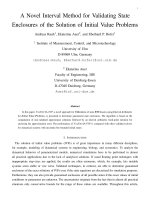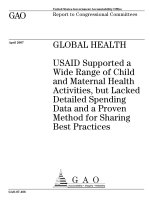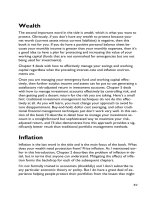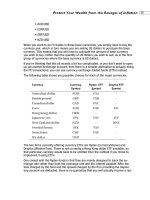everyone is a customer a proven method for measuring the value of every relationship in the era of collaborati phần 5 pdf
Bạn đang xem bản rút gọn của tài liệu. Xem và tải ngay bản đầy đủ của tài liệu tại đây (148.05 KB, 24 trang )
Purposeful
Collaboration
PART TWO
74 Part One
❘
Part Title
W
e ended the last section with a brief description of the
challenge facing everyone in business, whether a free
agent or a corporate executive: to identify his or her
most important relationships and then bring to those relation-
ships a continuous stream of value propositions that produce in-
creasing value for each person in the relationship.
However, as we’ve discussed, businesses have found that col-
laborative relationships are not easily quantified and controlled.
THE SOLUTION
Observing the problem, we developed an iterative method
for effectively analyzing the underlying relationships in business,
thereby allowing you to correctly evaluate which relationships
offer the greatest value. We refer to this method as Purposeful Col-
laboration—a process that allows you to trade in relationship cur-
rencies that clearly help both parties move toward their respective
75
Not All Relationships
Are the Same
CHAPTER 5
goals. Consequently, the objective of purposeful collaboration is to
create a win-win relationship while engaging in activities that sat-
isfy both parties’ customers and build a profitable business.
When you enter into purposeful collaboration, you clearly
identify the purpose of the interaction. It allows you to under-
stand what you have that is of value to the other party and
specifically what you seek from the business relationship with
the other party. With this knowledge, you can allocate the proper
resources (time, energy, and currencies) to your most important
relationships and thereby improve your performance and
achieve your goals. However, in order to manage your relation-
ships in this fashion, you first need to measure what you are re-
ceiving from each of your relationships. And to do that, you
have to establish values.
❚ Purposeful collaboration allows you to understand what
you have that is of value to the other party and specifically what
you seek from him or her.
How do you value what you receive from a relationship?
You start by analyzing every business relationship with re-
spect to (1) the nature of the relationship and (2) the rhythm of
the relationship. We use these two perspectives because the na-
ture of the relationship indicates how important a relationship
is for achieving your goals, whereas the rhythm of the relation-
ship provides a sense of your commitment of resources to that
relationship.
By evaluating every relationship from these two perspec-
tives, you can sort each relationship into one of the four quad-
rants shown in Figure 5.1.
When using the Relationship Matrix, first keep in mind that
it is designed from your perspective, not the other party’s. How-
ever, having said that, we need to stress that because everyone
you interact with should be viewed as a customer, the “other
76 Part Two
❘
Purposeful Collaboration
party” should be thought of with that mindset, encouraging you
to think of their needs, as you would any customer. Second, when
you categorize your relationships into one of the four quadrants,
you do so at a particular moment. In essence, just as a balance
sheet reflects the financial condition of a business at a specific
time (for example, as of December 31, 2002), so too does the Re-
lationship Matrix. Thus, if you examine your relationships on De-
cember 31, 2002, and then again on January 31, 2003, some of
those relationships may have shifted into a new quadrant as a re-
sult of the interactions that occurred during the month of January.
Now let’s take a closer look at the matrix (Figure 5.1) and
see how we define its two axes.
5
❘
Not All Relationships Are the Same 77
FIGURE 5.1
❘
Relationship Matrix
THE NATURE OF THE RELATIONSHIP
The nature of the relationship refers to whether you are re-
ceiving currencies that help you achieve your goals. If you are,
then that relationship is core. On the other hand, non-core rela-
tionships are all those other relationships that play a supporting
role in your business and don’t relate directly to achieving your
goals. That doesn’t mean they are not important on their own
terms; rather, it simply means they are not currently core to your
business.
❚ The nature of the relationship refers to whether you are re-
ceiving currencies that help you achieve your goals.
Setting S-M-A-R-T goals. When identifying your goals, make
sure every goal passes the “S-M-A-R-T” test. Make sure your
goals are Specific, Measurable, Attainable, Relevant, and Time
sensitive. And even though our process helps you achieve what-
ever goals you deem important, it’s our belief that your goals
should be related to the three core business processes that make
up the business model of a customer-centric, collaborative busi-
ness: (1) customer acquisition and retention—how you get and
keep your customers; (2) product and service innovation—how
you continually generate the solutions your customers desire;
and (3) customer fulfillment and service—how you deliver to
and service your customers. Therefore, to trade in relationship
currencies and use your resources most effectively, you must
focus on those relationships that help you carry out your core
processes.
❚ Make sure your goals are: Specific, Measurable, Attainable,
Relevant, and Time sensitive.
For example, you may use specific goals, such as signing up
100 new customers in the next six months or finding a contract
78 Part Two
❘
Purposeful Collaboration
manufacturer to produce a new product or finding a distribution
partner, and so forth. In fact, this goal-setting task is a powerful
tool for creating alignment throughout an organization. The
CEO may set broad goals, which then can be used as guidelines
for establishing the more narrowly defined goals of the individ-
uals responsible for carrying out the activities that in the aggre-
gate achieve the company’s broader goals.
CUSTOMERS CAN BE NON-CORE RELATIONSHIPS
Right now you may be thinking that all your customers
must be core relationships as one of the core processes is cus-
tomer acquisition and retention. But that isn’t quite correct. Cus-
tomer relationships can be non-core if the only exchange of value
is their paying you for your product and service and your fulfill-
ing and servicing their needs in the normal daily course of your
business. Although your business depends on customers like
these for continued financial health, they may not be core to
achieving your company’s current goals relative to expansion or
addressing new business challenges. Again we come back to the
question of alignment of goals throughout the organization. If
you’re the CEO, such customers may not be core relationships on
which to focus your personal energies as you go about achieving
the broader goals of the company. However, keeping customers
that routinely purchase without a fuss may be the most impor-
tant goal of the vice president of customer relationships.
UNDERSTANDING THE RHYTHM OF RELATIONSHIPS
The rhythm of a relationship relates to the patterned flow and
intensity of the interactions between you and the other party. Ac-
cording to Webster’s Dictionary, intensive means “constituting or re-
lating to a method designed to increase productivity by the
5
❘
Not All Relationships Are the Same 79
expenditure of more capital and labor.” Therefore, if the interac-
tions you have with the other person—whether face-to-face or by
e-mail or telephone—take place on a regular and intense basis, we
characterize them as intensive. If the interactions are intermittent
and limited, we characterize them as non-intensive. Because every
interaction involves the use of your limited resources—time, en-
ergy, and currencies—the rhythm of a relationship is a reflection
of the resources committed to that relationship. Intensive relation-
ships tend to use lots of resources; non-intensive relationships use
fewer resources.
❚ The rhythm of a relationship relates to the patterned flow
and intensity of the interactions in a relationship and reflects
the resources committed to that relationship.
As we’ve discussed, collaboration requires strong and
trusting relationships, which generally require an intensive
rhythm. Accordingly, look at all your relationships and assess
whether the commitment of resources to each is appropriate
given its value. For example, for a non-core relationship, seek to
minimize the commitment of resources through centralizing
contact, streamlining processes, introducing technology, and so
on. For a core relationship, commit the resources needed to en-
sure that both parties build the trust required to achieve strate-
gic and financial benefit.
Purposeful collaboration, whether with customers or busi-
ness partners, requires strong and trusting relationships. And, as
we’ve said, while these types of relationships consume resources
for their development and nurturing, they are worthwhile. With
each interaction, each party’s intent is to get closer to achieving
individual and mutual goals. Any other mindset doesn’t lead to
the desired results for either party.
Even though these relationships are intensive, in the long
run, if done correctly, they allow you to conserve your resources.
As each party in the collaboration is contributing its core com-
80 Part Two
❘
Purposeful Collaboration
petencies, each party is thus saving by focusing on those aspects
of its business that are most important and that it can accomplish
most effectively. No, you’re not going to find that elusive 25th
hour in the day. But whenever you save, you are implicitly cre-
ating because saving time, money, and energy increases your
freedom to get more things done.
The real incentive for forming collaborative relationships,
therefore, is a value proposition that brings increased value to each
party, and value is created when an exchange of currencies helps
you improve the efficiency and effectiveness of your core business
processes. That is, you can more quickly and less expensively val-
idate or invalidate the assumptions on which you designed your
core processes. Or, put another way, a relationship has value, even
if cash doesn’t change hands, if it helps you more quickly and less
expensively validate or invalidate the critical assumptions you’ve
made about your primary customers and your business model—
what your business does and how it intends to make money.
Recall the relationships Eric Bobby of CityKi has struck with
the technology vendor and the grocery store owner. One of Eric’s
assumptions about how he’ll generate revenue from the mer-
chants and service providers represented on his kiosks is by pro-
viding them with prominent advertising opportunities. By
working with his technology vendor to develop and manage the
media content of CityKi’s overhead screens, Eric can quickly val-
idate or invalidate that assumption. Another of Eric’s assump-
tions about how to bring users to his kiosks is to locate them in
high-traffic, safe locations like a grocery store, which people fre-
quent on a regular basis. He also believes it is important that his
initial kiosks are hosted by merchants who are respected in the
community. So the grocery store owner where he placed the first
kiosk is helping him to validate these important assumptions re-
garding customer acquisition. Accordingly, both relationships
have great value to Eric, even though no cash has changed hands.
Now let’s see how we characterize each of the four rela-
tionship types shown in Figure 5.1.
5
❘
Not All Relationships Are the Same 81
TRANSACTIONAL RELATIONSHIPS
A transactional relationship is a non-core relationship that
has a non-intensive rhythm. The frequency of interaction be-
tween you and the other party is relatively low and requires a
minimum level of resources. Look at it as if you and the other
person are essentially in balance. You’re not receiving something
of core value but then neither are you using a lot of resources,
and the same is true of the other person. Sometimes transactional
relationships are referred to as “arm’s-length relationships” in
that the parties do not have a relationship beyond the minimum
required to carry out the specific transaction. Clearly, all of us
have many necessary transactional relationships, even if they are
not core.
It is also important to appreciate that a relationship remain-
ing in the transactional quadrant over the long run is perfectly
acceptable and in fact expected. For example, you probably con-
sider your relationship with the landlord of space you rent as
transactional. On the first of every month you send the landlord
a check, and the landlord makes sure you have occupancy of the
rented space as specified in the lease. Having a transactional re-
lationship does not imply anything about your relationship
other than you are not committing a lot of resources, because the
currencies used in the value proposition do not add core value.
RESOURCE SINK RELATIONSHIPS
Arelationship characterized as a resource sink is one in
which the value accruing to you from the relationship is not
core, as is the case in a transactional relationship. However, un-
like a transactional relationship, there is an intensive rhythm in
a resource sink relationship. As we said, relationships that have
an intensive rhythm generally consume a lot of resources. And
82 Part Two
❘
Purposeful Collaboration
relationships that use a lot of resources but don’t provide core
benefits dissipate your time, energy, and currencies. A resource
sink relationship is out of balance in that you give to, but do not
get from, the relationship. More accurately, what you do receive
is out of proportion to what you expend. We can also look at this
as a lose-win relationship because you’re losing and you pre-
sume the other party is winning.
An example of a resource sink relationship. One of our cus-
tomers is an agricultural business. The company’s management
is passionately committed to preserving farmland and steward-
ship of the land in general. As such, over the past few years the
business has held a festival, the net proceeds of which it’s do-
nated to a not-for-profit organization, whose mission is to pre-
serve open space and farmland. While it was (and is) very happy
to make that contribution, it hadn’t looked to see what the orga-
nization might offer in return that would benefit them both.
Thus, our customer was giving more than it was getting, and
even though personally satisfying, the relationship was a re-
source sink from a business standpoint.
We don’t mean to imply anything negative about any per-
son with whom you have this kind of relationship other than
that it is wasting some of your resources. In fact, you may be-
lieve the relationship should be core, and thus you may be will-
ing to invest resources to iterate it to a core relationship. Before
we explained the situation, our customer knew intuitively its re-
lationship with the not-for-profit was important but hadn’t real-
ized how to make it core to its business. In Chapter 8, we’ll talk
more about how the company is turning this valuable, but
nonetheless resource sink, relationship into a collaborative one.
For now, let’s explain that if you allow an imbalance where you
are giving more than you are getting to persist, you risk running
out of resources. Consequently, you don’t want to maintain a re-
lationship in the resource sink quadrant. You must take action to
5
❘
Not All Relationships Are the Same 83
change the situation because a resource sink is not a viable long-
term type of relationship.
RESOURCE OPPORTUNITY RELATIONSHIPS
Arelationship characterized as a resource opportunity pro-
vides core value even though the rhythm of your interaction
with the other party is non-intensive, and you do not use a lot of
your resources—the exact opposite of a resource sink relation-
ship. You may view this as positive, and it is, but only if the other
party continues to provide his or her currencies. However, un-
less the rhythm of your interaction becomes more intensive, you
may not maintain the relationship. Essentially, what this rela-
tionship means is that the other party is providing currencies
that help you achieve your goals, but currently you are not com-
mitting a sufficient level of resources to help the other party
achieve his or her goals. Thus, you are getting more than you are
giving. In that case, it’s win-lose—you’re winning and you pre-
sume the other party is losing. As such, this is not a viable state
for a relationship over the long run.
An example of a resource opportunity relationship. Our col-
league, Dave Blakelock, relates how he successfully recruited the
athletic director of a major university to serve on the board of ad-
visors of a sports-related business Dave had begun. Over time,
the athletic director introduced Dave to several people who were
important to Dave. Yet Dave didn’t understand what benefit the
athletic director was getting from their relationship. Dave didn’t
know what currency he was offering that was valuable to the
athletic director, so he was hesitant to try to make the relation-
ship more intensive. From Dave’s perspective, he was winning
and his associate was losing. Knowing that was not a viable state
for the relationship, Dave asked why his associate continued to
offer currencies when Dave was offering nothing in return. Sur-
84 Part Two
❘
Purposeful Collaboration
prised, the athletic director responded that Dave offered him the
chance to participate in a business, something university life
didn’t offer. Now recognizing that both were receiving value,
Dave was willing to commit greater resources to the relationship
so that they both could receive even greater value from it.
COLLABORATIVE RELATIONSHIPS
A collaborative relationship is one in which the other party
provides core value to you and you provide core value to him or
her. And reflective of the value accruing to both, the rhythm of
the relationship is intensive.
But remember that building a collaborative relationship is
an iterative process. You have to move the relationship from one
in which there is just enough faith to forge the contract at hand
to a relationship of confidence and finally to a relationship of
proven trust. Only then do you both have access to all the cur-
rencies the other can put on the table, so you both can benefit.
(We’ll discuss this point in more detail in Chapter 9.) Our agri-
cultural business and the not-for-profit organization have begun
down this path. Among other things, they are working on ways
to jointly bring more customers to the farm and more members
to the organization.
And similar to a transactional relationship, a relationship in
the collaborative quadrant is viable because it is a win-win for
both parties.
Thus, we can now see how all business relationships fall
into one of the four quadrants. The resource sink and resource
opportunity relationships are not long term in nature because of
their lose-win and win-lose structure. (Remember, the quadrant
is assigned from your perspective.) By contrast, transactional
and collaborative relationships are viable win-win states. Hav-
ing said that, you must keep in mind that over time your goals
will change, and what is of value today may change tomorrow.
5
❘
Not All Relationships Are the Same 85
In addition, whom you want to build a collaborative relationship
with is likely to change. Most important, never forget that
achieving and maintaining success in business is a never-ending,
iterative process.
Obviously, it is impossible for all your relationships to be
collaborative. No one has a sufficient level of resources to main-
tain an intensive rhythm in every relationship. In fact, given the
value that collaborative relationships bring and the resources in-
volved in realizing that value, you’ll probably maintain relatively
few. You don’t need every relationship to be collaborative to be
successful. The ability to identify the most important relation-
ships and then bring to those relationships a continuous stream
of value propositions that produce increasing value for each
party is what is important. And integral to enhancing those value
propositions is the understanding and systematic use of cash and
non-cash relationship currencies as well as a method of valuing,
measuring, and managing the utility of those currencies.
❚ Integral to enhancing value propositions is the systematic
use of relationship currencies as well as a method of valuing,
measuring, and managing their utility.
CREATING A COLLABORATIVE RELATIONSHIP
Now that we understand the four different types of business
relationships, let’s take a look at how to turn a non-collaborative
relationship into a collaborative one.
The first step is to map the value proposition of the existing
relationship. By this we mean you spell out the specific value
proposition that currently exists between you and the other
party by identifying the bidirectional flow of goods, services, in-
formation, money, and access.
As an example, let’s again take the relationship you have
with your landlord. As we said, most likely you send the land-
86 Part Two
❘
Purposeful Collaboration
lord a check on the first of every month, and in return the land-
lord provides space and maintains it according to your lease. For
many companies, rent is often one of their largest expenses, so
their relationship with the landlord is important but not neces-
sarily core.
Another example is derived from our interactions with a
property owner and one of his business tenants. The tenant,
Dave, saw an opportunity for his landlord relationship to have
an impact on one of his core business processes. Dave believes
that the other tenants of his landlord (Max) are potential cus-
tomers for his (Dave’s) shipping and logistics services. Dave un-
derstands that if he can reach the landlord’s 300 other tenants, he
can reduce both the time and the cost to reach those potential
customers. In other words, Dave can validate or invalidate his
assumption that Max’s tenants are his potential customers more
quickly and for less money. But what’s in it for Max? His busi-
ness is developing and managing property, not offering some-
one else’s products to his tenants . . . or is it?
Dave understands that the power in business relationships
has shifted to customers, and even in a tight real estate market,
it is more economical for a tenant to renew a lease or move to an-
other space under the same landlord than for the landlord to
find a completely new tenant. So if Dave can help Max provide
a value-added service to his tenants, wouldn’t he be helping
Max develop his relationship with his tenants? And couldn’t
that developing relationship result in greater customer retention
and be turned into a new product offering and revenue stream
for Max? After all, Dave was willing to pay for access to the ten-
ants. Come to think of it, Dave’s friend Myer is in the messenger
business. Dave thought Myer might also want to offer services to
Max’s tenants.
Dave approached Max and discovered that Max had already
been thinking how he could be of greater value to his tenants. He
does want them to renew their leases rather than move on. And
Max wants to differentiate himself in the marketplace and in the
5
❘
Not All Relationships Are the Same 87
minds of real estate brokers. After his conversation with Dave,
Max now understands that with 300 tenants in a dozen buildings
located in the same city, he offers a distribution channel to ven-
dors and can use that access to customers to get discounts and
special services for his tenants/customers. So Max agreed to start
to transform his and Dave’s relationship. As the first iteration,
Max included a flyer in his tenants’ monthly bills announcing
that Dave and his friend Myer would offer shipping, logistics,
and messenger services at a reduced rate to tenants in Max’s
buildings. And Dave and Myer have agreed that after a trial pe-
riod to assess tenants’ interest, they will pay Max a fee for each
tenant that becomes their customer. It’s a small step but an im-
portant one. All three men have adopted a new perspective on
their relationship; but keeping our focus on Dave and Max, we
find they are expanding the exchange of value between them and
turning a transactional non-core relationship into a collaborative
one. And the benefit for both is that it immediately reduces the
cost of customer acquisition for Dave (plus increases the value he
gets from his rent) and provides Max with the beginning of a new
service/product offering for his tenants (discounts and special
services—starting with shipping, logistics, and messenger ser-
vices as seen in Figure 5.2) that he believes will help him retain
his tenants and provide a new revenue stream.
Now let’s think about Dave and Max’s relationship in terms
of the four quadrants shown in Figure 5.1. Before Dave ap-
proached Max with his new idea, their relationship, while a
good one, was transactional. From Dave’s perspective, the space
he was leasing, in and of itself, did not directly have an impact
on one of his core business processes; and the rhythm of the re-
lationship was non-intensive as Dave had limited interactions
with Max other than sending in his rent, thereby expending lim-
ited resources.
However, by approaching Max with a new value proposi-
tion, one in which they both realize increased value, Dave and
Max are transforming their relationship into a collaborative one:
a relationship that has a direct impact on one or more of the three
88 Part Two
❘
Purposeful Collaboration
core business processes. In Dave’s case, the new understanding
with Max results in access to potential customers (the tenants),
thereby having an impact on his customer acquisition and reten-
tion process. At the same time, the new value proposition adds
to Max’s product and service offerings (discounts and special
services) that are made available to his tenants and that Max
hopes will ultimately have an impact on his customer retention.
And if all goes well, Max will start earning fees from Dave.
We hope this simple example gives you a better under-
standing of the type of process you go through to move a rela-
tionship from a transactional relationship to a collaborative one.
In the next chapter, we’ll focus on how you can shift your rela-
tionships, interaction after interaction, iteration after iteration,
into a more desirable quadrant.
5
❘
Not All Relationships Are the Same 89
FIGURE 5.2
❘
Value Proposition Map
WHAT HAVE WE LEARNED?
1 ❚ The objective of purposeful collaboration is to create a win-win rela-
tionship while engaging in activities that satisfy both parties’ cus-
tomers and build a profitable business.
2 ❚ Start by analyzing every business relationship with respect to (1) the
nature of the relationship and (2) the rhythm of the relationship. We
use these two perspectives because the nature of the relationship
provides an indication of how important a relationship is for achiev-
ing your goals, whereas the rhythm of the relationship gives you a
sense of your commitment of resources to that relationship.
3 ❚ The nature of the relationship refers to whether you are receiving cur-
rencies from a relationship that help you achieve your goals. If you
are, then that relationship is core.
4 ❚ Non-core relationships are all those other relationships you have that
play a supporting role in your business but don’t relate directly to
achieving your goals.
5 ❚ When identifying your goals, make sure every goal passes the “S-M-A-
R-T” test—that is, each goal is Specific, Measurable, Attainable, Rele-
vant, and Time sensitive.
6 ❚ Customer relationships can be non-core if the only exchange of value
is their payment to you for your product and service and your fulfilling
and servicing their needs in the normal daily course of your business.
7 ❚ The rhythm of a relationship relates to the patterned flow and inten-
sity of the interactions between you and the other party.
90 Part Two
❘
Purposeful Collaboration
8 ❚ Collaboration requires strong and trusting relationships, which re-
quire an intensive rhythm of the relationship.
9 ❚ A relationship has value, even if cash doesn’t change hands, if it helps
you more quickly and less expensively validate or invalidate the criti-
cal assumptions you’ve made about how you intend to achieve your
goals.
10 ❚ A transactional relationship is a non-core relationship that has a non-
intensive rhythm.
11 ❚ A relationship characterized as a resource sink is one in which the
value accruing to you from the relationship is not core but has an in-
tensive rhythm.
12 ❚ A relationship characterized as a resource opportunity provides core
value even though the rhythm of your interaction with the other party
is non-intensive, thus not requiring you to use a lot of your resources.
13 ❚ A collaborative relationship is one in which the other party provides
core value to you and you provide core value to it. And reflective of
the value accruing to both,the rhythm of the relationship is intensive.
14 ❚ Never forget that achieving and maintaining success in business is a
never-ending, iterative process.
15 ❚ The ability to identify the most important relationships and then
bring to those relationships a continuous stream of value proposi-
tions that produce increasing value for each party is what is impor-
tant. And integral to enhancing those value propositions is the
understanding and systematic use of cash and non-cash currencies
as well as a method of valuing, measuring, and managing the utility
of those currencies.
5
❘
Not All Relationships Are the Same 91
he last chapter introduced the Relationship Matrix as a
way of looking at business relationships and assigning
them to one of four quadrants based on the nature and the
rhythm of the relationship. The benefit of this approach is that it
enables you to categorize all of your relationships in terms of
their ability to provide you with strategic and financial value.
At the same time, each of the four relationship quadrants
also reflects the resources you are committing to a relationship
relative to the currencies offered to you. Ideally, the perceived
value of the currencies you receive should influence the rhythm
of the relationship and help you decide the future level of re-
sources you commit to that relationship. Because this is most
likely the first time you have systematically surveyed the link-
age between the utility of the currencies you are receiving and
the resources you are committing, you probably have a number
of business relationships that are out of balance, in that you are
committing too many or too few resources. However, while it is
inevitable that some relationships will always be out of balance
93
Deciding Who to
Dance With
CHAPTER 6
(and some for good reason), it is obviously extremely important
to ensure that the total of the currencies you receive from your
network of relationships provides what you need to accomplish
your goals.
An additional complexity of business relationships is that
every interaction you have with an individual can lead to a
change in the currencies that relationship brings. Such change
should also lead to a diminution or increase in the intensity of re-
lationships. For example, you may learn from a meeting with
someone that she has just changed jobs, as a result of which she is
now able to bring different currencies to your relationship. In
view of the fact that the currencies she can now bring may either
add to or reduce her value to you, your own level of resource com-
mitment to her may warrant a change. Of course, these changes
can work in reverse. As your currencies change over time, those
changes alter the value you bring to your relationships, leading,
perhaps, to a change in the currencies others provide you.
We know that this all sounds very cold and calculating.
After all, relationships are between people and yet we don’t
seem to be factoring into the process the human aspects of rela-
tionships. And to be perfectly honest, to some extent you’re
right. But even though all business relationships are processed
through human beings, the purpose of the Relationship Matrix
is to momentarily take the human element out of the relation-
ship and allow you to analyze the business value of your rela-
tionships. Such an analysis is vital to the success of your
business, particularly in an age when collaboration is essential.
Our analysis is not about friendship; it is about how best to allo-
cate your energy and resources throughout your business day.
This allocation is a business decision, and business decisions
should be made on the basis of what is good for your business.
❚ The Relationship Matrix takes the human element out and
allows you to analyze the utility of your relationships relative to
your goals.
94 Part Two
❘
Purposeful Collaboration
Our intent is to demonstrate the benefit of using Purposeful
Collaboration to allocate your resources. Let’s consider a simple
example. Perhaps you’ve been asked to meet with someone to
network, and although you may have wanted to help, you felt
that given your existing commitments, you had no alternative
other than to say, “I’m sorry, I just don’t have the time right
now.” But let’s be honest; we all know that what you really meant
was that the meeting wasn’t important enough for you to reshuf-
fle your tight schedule. In other words, you were allocating your
resources but on the fly and without much analysis.
The problem is that your schedule may be filled with a num-
ber of things that are not important. And because you’re most
likely not systematically assessing the value of what you receive
from your relationships, you’re thus unable to take advantage of
more important opportunities. In contrast, by using the Relation-
ship Matrix, you can engage in Purposeful Collaboration with
your network of relationships and allocate your resources to
those that provide you the most value and leave you time to take
advantage of other opportunities as they come along.
We are not saying that every relationship has to be man-
aged by the dictates of the Relationship Matrix. Let’s look at an-
other example to see what we mean. Let’s say you have a vendor
that you’ve dealt with for a long time. And let’s say further that
this vendor was the first to offer your company credit; and the
owner gave you some good business advice along the way. Now,
however, the owner is a year from retirement and hasn’t kept his
business as up-to-date as he should have, and when you look at
your relationship via the matrix, you see that his company is a
borderline resource sink. His supplies are often late and some-
times wrong. However, you know your company is now an im-
portant customer, so you decide to stick with him for the next
year, and then if the new owner doesn’t modernize, you’ll find a
new supplier. Your decision, of course, is not made according to
the standards of the Relationship Matrix. In this case, it’s done
with your feelings of loyalty, but it’s also done with your eyes
6
❘
Deciding Who to Dance With 95









